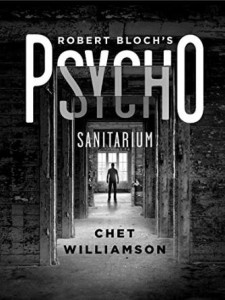Guest Post – Derek Farrell: Serial Heroes
When I see an author photographed in front of their bookshelves I know that I am not the only person that scans the books in the background to see what they read. Rather than wait for authors to share their “shelvies” I decided it was much quicker to ask them directly which books they enjoy reading the most.
This is the third run of my Serial Heroes features but you can catch up on Season 1 here. (Ed McBain, Jo Nesbo and Val McDermid all feature).
Season 2 is here and we had some love for James Bond, Stephen King and Batman (the ultimate serial hero)
Just after I finished the last run of Serial Heroes I fell into a Twitter chat with Derek Farrell about our mutual love of a series of stories we first read more than a couple of years ago. I asked Derek if he would join me to explain why this particular series appealed so much. Fortunately for the future of this feature he agreed – over to Mr Farrell…
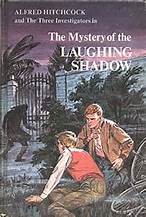 I was a quiet kid, with an obsession for books of all kinds.
I was a quiet kid, with an obsession for books of all kinds.
I didn’t make friends easily in the real world, but I made friends with the anthropomorphic cats and bears in Richard Scarry’s works, waded my way through the Famous Five books, was mates with The Hard Boys and Nancy Drew. And then something amazing happened:
My Dad bought me one of the Three Investigators books. It was The Mystery of The Laughing Shadow (Book 12 in the series), and there are a number of reasons why he might have thought the book would appeal to me:
 My dad and I loved Alfred Hitchcock, and the books – in an early approach to celebrity endorsement / branding – were introduced by the Auteur, who often featured as a character in them. They were published by the same people who published the Hardy Boys / Nancy Drew books, and they had similar formats and cover designs.
My dad and I loved Alfred Hitchcock, and the books – in an early approach to celebrity endorsement / branding – were introduced by the Auteur, who often featured as a character in them. They were published by the same people who published the Hardy Boys / Nancy Drew books, and they had similar formats and cover designs.
Whatever the reason, he picked right, and a loyal and true friendship that began in 1977 has endured to today.
By the time I was introduced to Jupiter Pete and Bob, the series had already been running for 13 years, having commenced in 1964 when Robert Arthur – who had previously edited several short story collections attributed to Alfred Hitchcock – sold the idea of a series of teenage mysteries to Random House.
Over time, other writers had contributed to the series, principally William Arden (who wrote The Laughing Shadow amongst others), Nick West, and Mary Virginia (MV) Carey, who wrote many of my personal favourites.
The head investigator, Jupiter Jones, lived with his Aunt and Uncle in a vast salvage yard, and had built – amongst the scrap and salvage – an operations centre with hidden entrances; a true boy’s den. The boys, too young to drive, were driven around – thanks to a competition win – in a chauffeur driven limo, and in “The mystery of The Magic Circle,” Carey dealt with the sad isolation of faded Hollywood Fame in the same stark fashion as ‘Sunset Boulevard,’ while the animosity between the boys and their sworn enemy, the perma-cocky Skinny Norris, whose bullying attempts to spoil their plans felt, so often, like a replay of my daily life, resonated with me.
And, through all that, the boys got to hang out with Alfred Hitchcock; they seemed, permanently, to be on some extended school vacation; they lived in Southern California, and their ability to move around the entire county on only pushbikes was simply taken for granted).
Many of the normal mundanities of life – school, homework, the general depressions of a childhood in 1980s Dublin – could simply cease to exist for as long as my nose was buried in a Three Investigator book.
I stopped buying them in 1986 when I moved to London and began working. I guess I figured I was grown up now, and it was time, as they say “To put aside childish things.”
But some years later, on a visit back to Dublin, I packed my entire collection into a suitcase and brought them back to London with me, their presence in my flat symbolising the fact that I had settled, that where I was – now that The Three Investigators were there with me – was finally home.
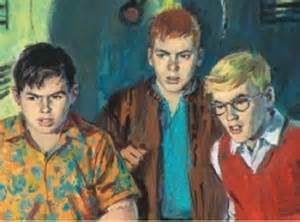 The investigators are lead by Jupiter Jones, a chubby, smart mouthed intelligent kid, who is a former child actor named “Baby Fatso” (although he hates it when people mention this). Jupiter is a prolific reader, often rubs his peers up the wrong way and is driven by his own morality and belief in the power of logic and creative thinking (So: not much psychology required there to figure out why I fell for this series).
The investigators are lead by Jupiter Jones, a chubby, smart mouthed intelligent kid, who is a former child actor named “Baby Fatso” (although he hates it when people mention this). Jupiter is a prolific reader, often rubs his peers up the wrong way and is driven by his own morality and belief in the power of logic and creative thinking (So: not much psychology required there to figure out why I fell for this series).
Jupiter was joined by Pete Crenshaw, the athletic leg of the trio, more likely to be the one who tackled the escaping criminal to the ground, though Pete was never drawn as being pure brawn without brains; he was as capable of challenging assumptions and of suggesting possible motives or viewpoints as the lead investigator.
Bob Andrews made up the trio. The researcher, who – in pre-Google days – would scour newspaper morgues, school libraries, and interview witnesses face to face, produced, often, the killer clue that Jupiter and Pete would then extrapolate into a solution to the mystery. Bob did all of this, in the early books, while wearing a leg brace to heal multiple leg fractures, thus – in late 60s / early 70s fiction – presenting a disabled person as a positive independent and equal contributor to the endeavour, and doing so in a way which never felt shoehorned in.
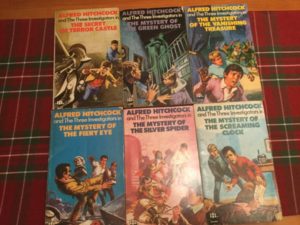
In fact, the boys also faced off against menace, threats of racism, fatism, classism and all the other ‘ism’s which, whilst entirely present in much of today’s YA market, were definitely unique at the time.
I can barely imagine any of Enid Blyton’s detective gangs facing down someone trying to swindle a Mexican family out of their ranch purely because of their race, let alone the Secret Seven dealing with obsession or the supernatural (Whispering Mummy), and as a result, for me, these books became an escape. When life was too dull, or too stressful, or when I felt lost or unsure of how / if I would ever fit into the world, Jupe, Pete and Bob would be there, to welcome me home.
The books were written by the various authors in a style that could be described as Pulp-Lite. The story started almost on the first page (if not the first line), the writing was snappy and direct. There were outlandish titles (“The Secret of Skeleton Island,” “The Mystery of The Moaning Cave,” “The Mystery of The Headless Horse” to name a few) designed to pull the readers in, and explanations that – at the end of the book – made absolutely perfect sense in light of what had been planted through the plot up to that point.
Chapters ended, mostly, on cliffhangers, and the danger was real. In “The Magic Circle,” for example, Bob is bashed on the head, knocked unconscious, dumped in the trunk of a car in the middle of a scrap yard in Southern California, and left to die of heat stroke. Beat that, Famous Five.
And the victory – when the villains are finally unmasked and the case resolved – all the sweeter for being logical, just, and a fair response to the threat created earlier in the book.
And now I write books. Mystery books. Books peopled with characters who run the gamut from loveable to quirky to monstrous, and who are all (or mostly) comfortable in their own skins.
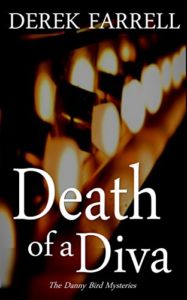 In Death of a Diva and Death of a Nobody, Danny Bird – my detective – is an average Joe, who just at the point when he thinks he’s lost everything, finds a new purpose in life. He’s accompanied by his best friend, a ridiculously glamorous yet heartwarmingly fallible gorgeous blonde, and surrounded by family – made as well as birth – who bicker, bitch, backbite and yet – when the chips are down – are there for each other.
In Death of a Diva and Death of a Nobody, Danny Bird – my detective – is an average Joe, who just at the point when he thinks he’s lost everything, finds a new purpose in life. He’s accompanied by his best friend, a ridiculously glamorous yet heartwarmingly fallible gorgeous blonde, and surrounded by family – made as well as birth – who bicker, bitch, backbite and yet – when the chips are down – are there for each other.
All ideas that – now I think about it – were instilled in me by The Three Investigators, by a series of books that didn’t talk down to their audience, but which made the assumption that their audience were smart, generous, and along for the ride.
I owe Robert Arthur and MV Carey particularly a great debt, and one I hadn’t fully realised until recently.
The books have been somewhat bogged down in legal wrangles in recent years, but I still firmly believe they have a place in the pantheon next to other more recognised series’ and can’t imagine my life – as a kid, as an adult, or as a writer of crime fiction that entertains and celebrates life in all it’s difference – without The Three Investigators.
Death of a Diva (Hyperurl.co/Diva) 
Death of a Nobody (Hyperurl.co/Nobody)
Publisher: Fahrenheit Press (@fahrenheitpress on Twitter).
My website is derekfarrell.co.uk
Twitter: @derekifarrell
